Contemporary art in the concrete donut: The Hirshhorn turns 50
The national museum was born thanks to a collector’s donation of 12,000 works. An exhibition of its treasures celebrates the anniversary of its Washington D.C. location, an icon of Brutalist architecture


Two architectural styles have traditionally been used in Washington D.C. to speak the language of power, perhaps the only tongue the capital truly understands. One is the Neo-classicism of the White House, with its neat faith in the ideals of democracy. The other is Brutalism, grim, cheap and versatile, which served the mid-20th century U.S. government in housing a rapidly-growing administration and in projecting the image of its dominance over the free world. Examples of the latter include the city’s subway and the nightmarish FBI headquarters. There are also apartment buildings, embassies and Marcel Breuer’s masterful Housing Department, as well as a round museum, the Hirshhorn, whose opening just half a century ago managed, in a city accustomed to disagreement, to be criticized by everyone.
With its monolithic, circular shape, nearly free of windows and elevated on four pillars, the Hirshhorn Museum and Sculpture Garden was quickly compared to a large concrete donut, a bunker, a military turret and a gas tank. Ada Louise Huxtable, feared New York Times architecture critic, even coined a new style to describe the structure: “Born‐dead, neo‐penitentiary modern,” she wrote. The passage of time eventually put things in their aesthetic place and now Gordon Bunshaft’s building, led by the Skidmore, Owings and Merrill firm, is a mainstay of the National Mall, though the world continues to be divided between those who see in Brutalism the sublime expression of the Modernist dream and those who still can’t help but think of a parking lot when they contemplate its buildings.
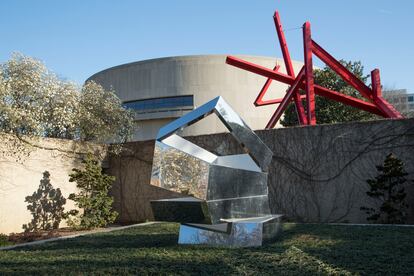
The Hirshhorn is a Smithsonian museum and is the only national museum in the United States dedicated exclusively to modern and contemporary art. “Not only that, it’s also the only one where it is free to enter,” its director, the Australian Melissa Chiu, explains in an interview that takes place in her office on the museum’s top floor.
Chiu took on her role in 2014, the year of the museum’s 40th anniversary. Her primary mission is to watch over the 12,000 works of Joseph Hirshhorn (1899-1980), a Latvian businessman who, though he made his fortune in uranium, was known for his white lies to cover his frequent escapes from work to satisfy a collector’s cravings. He was also famous for impulsively buying entire exhibitions or whatever was available in the studio of a certain artist, and for doing so, until the mid-1950s, without the guidance of any art advisor. Stéphane Aquin explains in one of the museum’s catalog texts that in the good old days (up until the mid-1960s), Hirshhorn bought “at an exceptional rate of two works per day.”
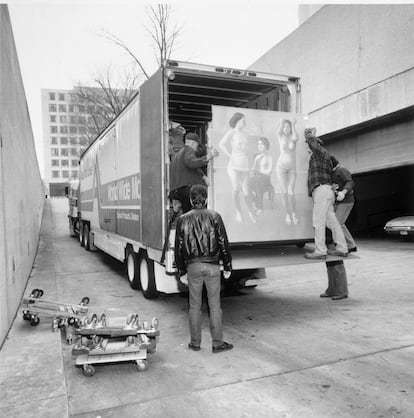
Some 200 of these pieces make up the exhibition Revolutions, the first of three with which the museum plans to commemorate the 50 years that have passed since its opening on October 4, 1974. The project revisits a century of art that lasted from 1860 to 1960. The list of pieces that will be shown, at which the museum arrived “though an arduous selection process,” according to curator Marina Isgro, who worked on the exhibition alongside Betsy Johnson, is an incomparable assemblage of masterpieces, beginning with a Rodin sculpture and continuing with Mondrians, Picassos, Brancusis, O’Keeffes, Twomblys, a good portion of Giacomettis and Calders, a sublime oil painting by Lee Krashner and two extraordinary Mirós. Throughout the entire half-century, never have so many of the works been exhibited together at the same time.
Never-before-seen pieces
There are 64 pieces that have never been displayed, such as a painted book by Sonia Delaunay, finally with its correct date of 1914, which rubs shoulders with a spectacular aerial view of the Eiffel Tower by her husband, Robert Delaunay. Also notable is the curators’ eagerness to update the collection’s discourse, interspersing contemporary pieces to, according to Isgro, “show that today’s artists build on the works of their predecessors” and also to, “fill in the gaps of Hirshhorn’s legacy.”
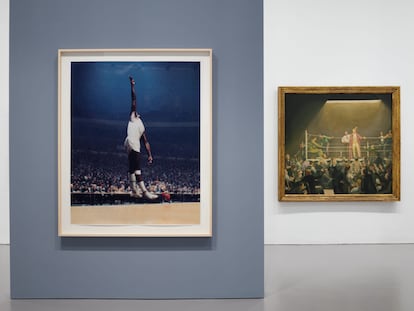
That first goal is clearly expressed by the juxtaposition, amid a fundamentally chronological discourse, of anachronistic pairings, like that formed by one of the famous Georges Bellows boxing paintings and a piece from a series on the NBA by Paul Pfeiffer. The latter goal stated by Isgro has been achieved by her and Johnson through giving prominence to certain works (such as a painting by Germany’s Janet Sobel) and by introducing Black artists (Tokwase Dyson, Nathaniel Mary Quinn), Ghanian portraitists (Amoako Boafo) and Native American painters (Dyani White Hawk).
Towards the end of one’s visit one finds Four Talks, a black room with messages written in white that Laurie Anderson created for her 2021 temporary exhibition at the museum and which has become a permanent installation. A plaque serves as a reminder that Hirshhorn collected as “a white Western male” and that the museum’s curators have availed themselves of the acquisitions program to correct the “underrepresentation of works by women and artists of color.”
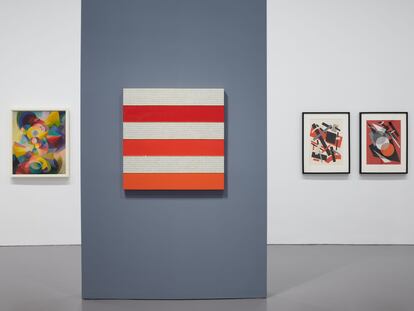
The exhibition, explains Chiu, is “a way of recognizing the past, the origin of the museum” and, at the same time, of “showing the evolution of the adminstration of an institution like this.” “How to reflect what is happening today? What do the artists think and how do we confront the responsibility of collecting for posterity? In Hirshhorn’s day, you could count the collectors of his kind on the fingers of one hand. Now, there are many more, and it’s not always possible to compete with them. That determines our interests when it comes to buying. As a consequence, we pay attention to emerging names and to those who don’t occupy a central space on the market,” says the director, who says that when she arrived to her position, she realized that up until that point, there had only been one important exhibition of a woman artist.
In another example of his generosity, Hirshhorn gave permission in the founding documents of the museum for its administrators to liquidate funds in order to finance new acquisitions. In the 2023 fiscal year, the institution bought more than 80 works by 45 artists, some of whose purchases were conducted in collaboration with other Smithsonian museums.
Chiu says that the museum’s origin began well before the opening of its building. “Congress decided to endow Washington with a center for modern art. And Dillon Ripley, then secretary of the Smithsonian, was struck by an exhibition that the Guggenheim in New York dedicated in 1962 to Hirshhorn’s collection of modern sculpture. Why not go for that collection?” she says. There began the courtship of the entrepreneur, whose treasures were already in demand in cities from London to Zurich, Florence to Tel Aviv.
Ladybird Johnson, First Lady and spouse of Lyndon B. Johnson, proved instrumental in getting the collection for Washington D.C. The couple invited Hirshhorn to dine at the White House, an offer that the immigrant Jew who had arrived as a young boy to the United States couldn’t resist. When the museum opened, the magnate explained in a speech that his 1966 donation of 6,000 works, with 6,400 to follow upon his death, was “a modest manner of giving back to the nation” what it had given to him “and to others who arrive as immigrants.”

Congress designated a space, previously home to a museum of military medicine, as well as $15 million to the operation, and the collector added another million towards the construction of the Brutalist building and adjacent garden, where masterpieces by Robin and Henry Moore are exhibited, as well as Yoko Ono’s Wish Tree. The garden is closed at the moment, undergoing the second round of renovations that have taken place in its history, under the guidance of Japanese conceptual photographer Hiroshi Sugimoto. Famous for his black-and-white images that reflect on time and modernity, Sugimoto redesigned the museum’s lobby in 2008.
Chiu has a mockup of the new garden in her office, perhaps as a reminder that it’s not always easy in Washington to move a project like this forward: shortly before she was hired, a polemic plan to create an inflatable structure on the museum’s patio was cancelled. The garden’s renovation could be the most lasting contribution the director makes to the city in which she’s lived for the last decade.
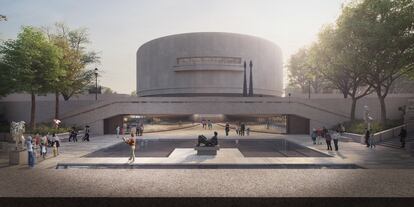
Bunshaft created the garden to exhibit sculptures, an essential part of the Hirshhorn collection, and as a kind of semi-enclosed area sunken beneath the rest of the National Mall. After this round of renovations, which are not without controversy over their choice of materials and creation of a new pond, the garden will improve in accessibility upon its 2026 reopening, Chiu says. “It will become the natural gateway to the museum. Right now, it is only receiving about 150,000 visitors, compared to the nearly one million who accessed the building in the figures we had before the pandemic. Considering that the Mall is visited by between 25 and 35 million people every year, I think we can hope that, if we open it up to that space, those numbers will improve,” she says. Between January and December 2023, the Hirshhorn, even with its garden closed, received 714,684 annual visits.
Sugimoto had an exhibition in the Hirshhorn in 2006, and since then has remained connected to the museum, which is accustomed to cultivating relationships with the artists with which it works. Sometimes, a piece from a temporary exhibition will stay on in the permanent collection, as has been the case with Laurie Anderson’s room and the 130-meter panopticon that Mark Bradford created in 2017 from Paul Philippoteaux’s cyclorama of the Battle of Gettysburg (now housed by the Pennsylvania museum the commemorates that Civil War conflict).
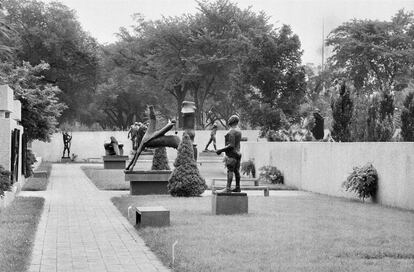
On other occasions, as with the case of Theaster Gates, artists may wind up on the Hirshhorn’s board of directors. Gates, says Chiu, helped out during the pandemic in imagining how a museum could continue serving its function despite shuttering for nearly two years. They asked 50 creatives from around the world to send in videos about how they lived during those months in lockdown. “We also had the opportunity to put into practice all of our ideas about what a virtual museum should be. We translated what we do in the building to the internet: exhibitions, artist talks — we even organized a gala,” says the director. At the same time, they took advantage of the closure to make improvements to the building.
The next exhibition will be that of OSGEMEOS; the Brazilian street artists are currently working in situ in the Hirshhorn galleries in preparation for their opening, which is scheduled for the end of September. A few days later, it will officially have been 50 years since the Brutalist monolith opened in Washington within the grand Neo-classical park of the Mall, set on modernizing the vast symbolic space in which the United States tells its story and, in so doing, the city’s artistic panorama.
Sign up for our weekly newsletter to get more English-language news coverage from EL PAÍS USA Edition
Tu suscripción se está usando en otro dispositivo
¿Quieres añadir otro usuario a tu suscripción?
Si continúas leyendo en este dispositivo, no se podrá leer en el otro.
FlechaTu suscripción se está usando en otro dispositivo y solo puedes acceder a EL PAÍS desde un dispositivo a la vez.
Si quieres compartir tu cuenta, cambia tu suscripción a la modalidad Premium, así podrás añadir otro usuario. Cada uno accederá con su propia cuenta de email, lo que os permitirá personalizar vuestra experiencia en EL PAÍS.
¿Tienes una suscripción de empresa? Accede aquí para contratar más cuentas.
En el caso de no saber quién está usando tu cuenta, te recomendamos cambiar tu contraseña aquí.
Si decides continuar compartiendo tu cuenta, este mensaje se mostrará en tu dispositivo y en el de la otra persona que está usando tu cuenta de forma indefinida, afectando a tu experiencia de lectura. Puedes consultar aquí los términos y condiciones de la suscripción digital.
More information
Archived In
Últimas noticias
Most viewed
- Oona Chaplin: ‘I told James Cameron that I was living in a treehouse and starting a permaculture project with a friend’
- Reinhard Genzel, Nobel laureate in physics: ‘One-minute videos will never give you the truth’
- Sinaloa Cartel war is taking its toll on Los Chapitos
- Why the price of coffee has skyrocketed: from Brazilian plantations to specialty coffee houses
- Silver prices are going crazy: This is what’s fueling the rally










































